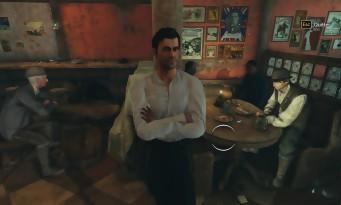 The game offers us five independent investigations, which revolve around a global scenario, notably featuring the adopted daughter of Sherlock Holmes. The differences with the original work of Sir Arthur Conan Doyle are obviously very numerous, but the video game version of the British detective took its independence a long time ago. However, the Frogwares studio has decided to push the cork a little further this time, since Sherlock Holmes and John Watson are entitled to an extreme makeover, which transforms them into handsome thirtysomething kids. A metamorphosis that is part of a strong trend, already initiated in recent years in the cinema and in various television series. Depending on his sensitivity, we can rejoice or regret it. This little update is necessarily good for the two heroes, but it somewhat breaks the continuity of the video game series. And above all, the divorce with the literary work becomes frankly consumed, since the books describe Sherlock Holmes as a sixty-year-old...
The game offers us five independent investigations, which revolve around a global scenario, notably featuring the adopted daughter of Sherlock Holmes. The differences with the original work of Sir Arthur Conan Doyle are obviously very numerous, but the video game version of the British detective took its independence a long time ago. However, the Frogwares studio has decided to push the cork a little further this time, since Sherlock Holmes and John Watson are entitled to an extreme makeover, which transforms them into handsome thirtysomething kids. A metamorphosis that is part of a strong trend, already initiated in recent years in the cinema and in various television series. Depending on his sensitivity, we can rejoice or regret it. This little update is necessarily good for the two heroes, but it somewhat breaks the continuity of the video game series. And above all, the divorce with the literary work becomes frankly consumed, since the books describe Sherlock Holmes as a sixty-year-old...
HOLMES, SWEET HOLMES
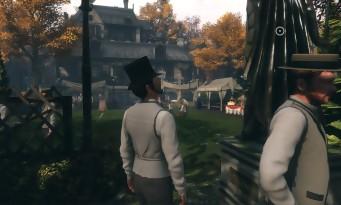 Come on, let's ignore the past and focus on the present! Let's address in particular the question of the gameplay which, if it is inspired at the base of the canons of the adventure game, does not hesitate in practice to deviate from it more and more. On the form first of all, since for a few episodes already, Sherlock Holmes is controlled by choice in the first or third person, and evolves in decorations supported by the Unreal Engine and very pleasant to the eye. By the way, the modeling of the different characters is rather well made, even if some too stiff animations would have deserved a little more work. Basically, The Devil's Daughter is richer than ever and, beyond the usual search for clues in the sets, is adorned with multiple activities. Thus, we regularly have the opportunity to draw a portrait of the characters we meet. The camera then zooms in on them, and then we move it around looking for clues, some of them being revealed automatically, and others asking us to choose from among several proposals (this little boy whose father has disappeared does he have red eyes from conjunctivitis or recent grief?). If you want to be sure not to go wrong, just focus on the list of clues which, before revelation, still appears in a blurred way on the right of the screen. A good way to leave the player free to impose his own challenges. In any case, making an incomplete portrait will not have serious consequences. Similarly, it is possible during certain dialogues to dispute or support the words of our interlocutor, by choosing proof (material or from a dialogue) from a given list. Again, no real penalty in case of error, just a few lines of dialogue less.
Come on, let's ignore the past and focus on the present! Let's address in particular the question of the gameplay which, if it is inspired at the base of the canons of the adventure game, does not hesitate in practice to deviate from it more and more. On the form first of all, since for a few episodes already, Sherlock Holmes is controlled by choice in the first or third person, and evolves in decorations supported by the Unreal Engine and very pleasant to the eye. By the way, the modeling of the different characters is rather well made, even if some too stiff animations would have deserved a little more work. Basically, The Devil's Daughter is richer than ever and, beyond the usual search for clues in the sets, is adorned with multiple activities. Thus, we regularly have the opportunity to draw a portrait of the characters we meet. The camera then zooms in on them, and then we move it around looking for clues, some of them being revealed automatically, and others asking us to choose from among several proposals (this little boy whose father has disappeared does he have red eyes from conjunctivitis or recent grief?). If you want to be sure not to go wrong, just focus on the list of clues which, before revelation, still appears in a blurred way on the right of the screen. A good way to leave the player free to impose his own challenges. In any case, making an incomplete portrait will not have serious consequences. Similarly, it is possible during certain dialogues to dispute or support the words of our interlocutor, by choosing proof (material or from a dialogue) from a given list. Again, no real penalty in case of error, just a few lines of dialogue less.
Basically, The Devil's Daughter is richer than ever and, beyond the usual search for clues in the sets, is adorned with multiple activities.
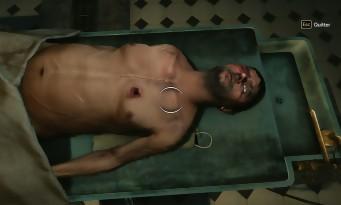 In general, the game guides us permanently (even if we will see later that a certain degree of freedom is left to us during the conclusion phases of the investigations). Thus, the various "powers" available to Sherlock Holmes can only be triggered at certain very specific times, which we are clearly told via the appearance of a specific icon on the screen. For example, we can switch to detective view in certain places, so that details are displayed in yellow highlighting that would go unnoticed by ordinary mortals. In other places, we will trigger our gift of imagination, in order to visualize in bluish silhouettes objects missing in the sets, and past or future events. Finally, we will use here and there our gift of concentration to spy on a conversation or even walk in balance on a beam. Concretely, it is necessary to control two small circles which move randomly, using the two sticks of the joystick or the keyboard/mouse couple. The opportunity is given to us here to specify that the game is played a little more easily with the joystick than with the keyboard, not only during the concentration tests, but also in the general handling of the interface. A defect which would be completely understandable for a platform game for example, but which is a little more difficult to accept for an adventure game, as the genre is historically linked to the PC and therefore to the keyboard/mouse pair.
In general, the game guides us permanently (even if we will see later that a certain degree of freedom is left to us during the conclusion phases of the investigations). Thus, the various "powers" available to Sherlock Holmes can only be triggered at certain very specific times, which we are clearly told via the appearance of a specific icon on the screen. For example, we can switch to detective view in certain places, so that details are displayed in yellow highlighting that would go unnoticed by ordinary mortals. In other places, we will trigger our gift of imagination, in order to visualize in bluish silhouettes objects missing in the sets, and past or future events. Finally, we will use here and there our gift of concentration to spy on a conversation or even walk in balance on a beam. Concretely, it is necessary to control two small circles which move randomly, using the two sticks of the joystick or the keyboard/mouse couple. The opportunity is given to us here to specify that the game is played a little more easily with the joystick than with the keyboard, not only during the concentration tests, but also in the general handling of the interface. A defect which would be completely understandable for a platform game for example, but which is a little more difficult to accept for an adventure game, as the genre is historically linked to the PC and therefore to the keyboard/mouse pair.
EXCLUSIVE INVESTIGATIONS
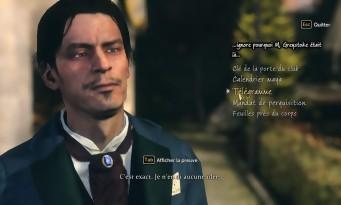 But let's go back to our dear detective's list of activities! Sherlock Holmes can search his archives for information needed to validate evidence, use his analysis table to dissect or put certain elements under the microscope, and play multiple mini-games necessary to advance investigations. Some are very classic for an adventure game (picking locks, setting up gears, etc.) and others take the form of action sequences (quite elementary, my at Watson), or even infiltration ( rudimentary). For example, we will have to follow a suspect by hiding regularly behind decorative elements or, on the contrary, escape a pursuer through swamps, using the detective view to identify safe areas. Or even progress in a Mayan temple, escaping traps that neither Lara Croft nor Indiana Jones would deny (walls with moving nails, rock in a corridor, trapped slabs on the ground, etc.). If sequences of this type have the merit of always bringing more variety to the gameplay, they are generally quite unsuccessful, the fault of rough maneuverability and poorly balanced difficulty. Fortunately, the game gives us the option of skipping most of the mini-games, which are then automatically solved.
But let's go back to our dear detective's list of activities! Sherlock Holmes can search his archives for information needed to validate evidence, use his analysis table to dissect or put certain elements under the microscope, and play multiple mini-games necessary to advance investigations. Some are very classic for an adventure game (picking locks, setting up gears, etc.) and others take the form of action sequences (quite elementary, my at Watson), or even infiltration ( rudimentary). For example, we will have to follow a suspect by hiding regularly behind decorative elements or, on the contrary, escape a pursuer through swamps, using the detective view to identify safe areas. Or even progress in a Mayan temple, escaping traps that neither Lara Croft nor Indiana Jones would deny (walls with moving nails, rock in a corridor, trapped slabs on the ground, etc.). If sequences of this type have the merit of always bringing more variety to the gameplay, they are generally quite unsuccessful, the fault of rough maneuverability and poorly balanced difficulty. Fortunately, the game gives us the option of skipping most of the mini-games, which are then automatically solved.
But all the subtlety of this system comes from the fact that it is possible, by committing several consecutive errors, to arrive at a totally false conclusion. Surprisingly, the game then gets rid of all linearity and leaves us the possibility of closing a case in an erroneous way.
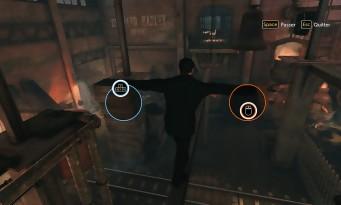 At times, this episode also tripped over linearity, especially when we understood faster than our avatar what we had to do, but it was forbidden for us until we found the last clue to a scene, however insignificant. And commits a few blunders, like this sequence where we find ourselves sniffing out a trail in the skin of the dog Toby. An interesting idea, but which falls a little flat when we realize that our canine status does not prevent us from opening the doors of buildings… Fortunately, the audacity which The Devil's Daughter regularly demonstrates also pays off at times. Thus, we particularly appreciated the interactive loading times, which take the form of a trip in a cab during which we can consult the various elements we have in our inventory (material evidence, clues, past dialogues, etc.). A good way to take stock between two sequences without wasting time. But it is above all the deduction system of the game that hits the mark. Throughout each investigation, Sherlock Holmes can create links between different clues, in order to form a deduction, which is then placed in a graphical representation of the detective's neural network. Some of these deductions are "fixed", but others leave the choice between several possible interpretations. It is up to the player to choose the one that seems most likely to him, even if it means reaching an impasse when several neural paths contradict each other. But all the subtlety of this system comes from the fact that it is possible, by committing several consecutive errors, to arrive at a totally false conclusion. Surprisingly, the game then gets rid of all linearity and leaves us the possibility of closing a case in an erroneous way. Similarly, each end of the investigation places us faced with a moral choice, a bit like Telltale games, with display of the percentage of players who have made the same choice as us. Never perfect but always daring, Sherlock Holmes: The Devil's Daughter is therefore ultimately worth the detour, as long as we are able to overcome these few flaws.
At times, this episode also tripped over linearity, especially when we understood faster than our avatar what we had to do, but it was forbidden for us until we found the last clue to a scene, however insignificant. And commits a few blunders, like this sequence where we find ourselves sniffing out a trail in the skin of the dog Toby. An interesting idea, but which falls a little flat when we realize that our canine status does not prevent us from opening the doors of buildings… Fortunately, the audacity which The Devil's Daughter regularly demonstrates also pays off at times. Thus, we particularly appreciated the interactive loading times, which take the form of a trip in a cab during which we can consult the various elements we have in our inventory (material evidence, clues, past dialogues, etc.). A good way to take stock between two sequences without wasting time. But it is above all the deduction system of the game that hits the mark. Throughout each investigation, Sherlock Holmes can create links between different clues, in order to form a deduction, which is then placed in a graphical representation of the detective's neural network. Some of these deductions are "fixed", but others leave the choice between several possible interpretations. It is up to the player to choose the one that seems most likely to him, even if it means reaching an impasse when several neural paths contradict each other. But all the subtlety of this system comes from the fact that it is possible, by committing several consecutive errors, to arrive at a totally false conclusion. Surprisingly, the game then gets rid of all linearity and leaves us the possibility of closing a case in an erroneous way. Similarly, each end of the investigation places us faced with a moral choice, a bit like Telltale games, with display of the percentage of players who have made the same choice as us. Never perfect but always daring, Sherlock Holmes: The Devil's Daughter is therefore ultimately worth the detour, as long as we are able to overcome these few flaws.


























